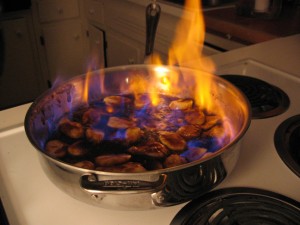
Yesterday I made a batch of strawberry jam. (Those who follow me on Facebook know jam making is something of an obsession.)
Well, I walked away at the wrong moment and the jam burned. The bottom layer went beyond “carmelized” to “carbonized.” Charred black, fused to the stainless steel bottom of the pan.
I just hate that.
You probably didn’t tune in for kitchen tips, but I can tell you how to get a really bad cooking mistake off of the stock pot your wife brought into the marriage.
Cleanup:
- Wash and scrub the gooey layer off.
- Add water.
- Add heat. Lots of heat.
- Use a spatula to swipe/nudge/scrape it off.
Heat loosens the bad stuff.
You just adapt a basic cooking technique: “deglazing” a pan. When you get that nice crusty layer on the pan after browning a piece of meat you don’t want to waste it. That’s a whole lot of flavor on the bottom of your pan.
Deglaze:
- Move the meat to a plate.
- Add some wine or stock.
- Add some heat. Not too much.
- Use a wooden spoon to swipe/nudge/scrape if off.
That, my friend, is the start of an excellent sauce for your steak, or a braising liquid for your roast.
Heat changes what you thought was bad stuff into good stuff.
And what, you rightly ask, does all this musing on cooking and cleaning have to do with the Heidelberg Catechism?
It is all about finding a way to think about Jesus’ suffering and the difficult issue of God’s wrath.
37 Q. What do you understand by the word “suffered”?
A. That during his whole life on earth,
but especially at the end,
Christ sustained
in body and soul
the wrath of God against the sin of the whole human race.
This he did in order that,
by his suffering as the only atoning sacrifice,
he might deliver us, body and soul,
from eternal condemnation,
and gain for us
God’s grace,
righteousness,
and eternal life.
I’ve written about wrath before. I guess I don’t like the concept any better than the rest of post-modern culture. But it is there in Scripture, and so there it is in the Catechism.
Heidelberg seems to go two different directions on wrath.
- A couple of passages argue that certain things we do make God displeased with us. That’s the unpleasant side.
- A couple of others are like the one above.
Look at it carefully:
1. God’s wrath is directed at sin, not at people:
the wrath of God against the sin of the whole human race.
Sin is that charred-on stuff that wrecks a perfectly good pan.
2. God’s attention toward us is actually favorable:
…that he might deliver us, body and soul…and gain for us God’s grace…
Like when I “deglaze” the crust of my botched jam project, God applies some heat. The heat, the purifying energy that removes the crust caused by my bad choices, is Jesus.
Jesus comes to us, enters the world of passions, this life of suffering, and makes me clean again.
We Protestants instantly think of the cross as the place of Christ’s suffering, and surely that was its most intense focus. By contrast, the Catechism rings a very ancient note by saying that Christ actually suffered “during his whole life on earth.”
God in heaven is beyond any change or suffering. Just being in time, the realm of change, of passion, of disease and discomfort, was suffering for the God who did not have to be here.
He came for us. His suffering frees us and makes us pure again.
———–
I’d love to hear from you in the comments. Ever felt “deglazed” by the presence of Jesus?

I have a question about this part of the catechism:
“Christ sustained
in body and soul
the wrath of God against the sin of the whole human race.
This he did in order that,
by his suffering as the only atoning sacrifice,
he might deliver us, body and soul…”
Firstly, what is meant by “suffering,” and what is meant by “sacrifice”? I’ve seen some take “suffering” to mean that the Son of God has to endure intense physical pain (e.g., Mel Gibson’s Passion of Christ); and I’ve seen some understand “sacrifice” as a debt that needs to be paid – but to whom? to God? to Satan? to Death?
How would Calvin, or the Heidelberg Confession answer this?
Thanks.